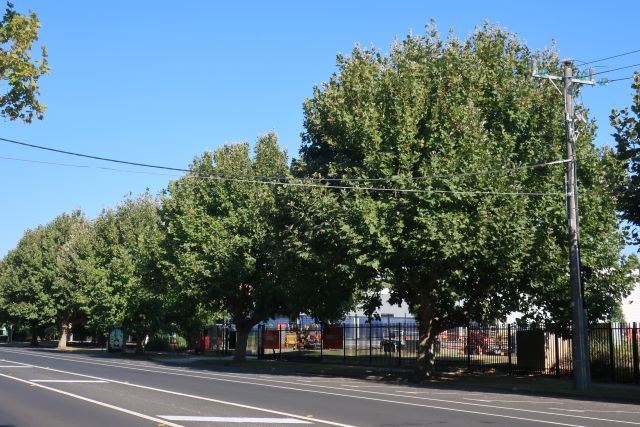
Two trees in the urban forest
A healthy urban forest is diverse. It is made up of trees of various ages – from venerable trees to saplings. It is made up of many kinds of trees – it does not over rely on one or two species. It is many layered – from the crown, to the mid-storey to the under-storey.
Mitigating the heat island effect, cooling the city, is a central goal of all urban forest strategies.
This is where the London Plane tree, plantanus x acerifolia, comes into its own. Plane trees make up 10% of Port Phillip’s 43,894 trees (the percentage is lower in Port Melbourne)1. In Middle Park and Elwood, plane trees meet in what urbanist Brent Toderian calls ‘a kissing canopy’, the ultimate in the shading and cooling sought by an urban forest strategy.
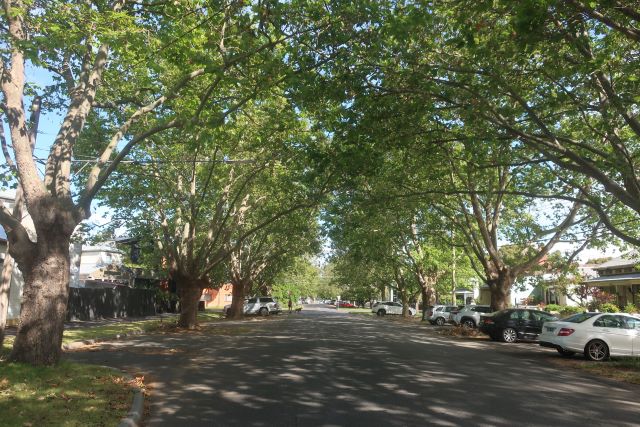
In the 17th century, English writer John Evelyn noted this attribute of the plane in his discourse on trees, Sylva.
‘Pliny affirms, there is no tree whatsoever which so well defends us from the heat of the sun in Summer, nor that admits it more kindly in Winter’2.
Plane trees are known for being tough survivors in urban environments – tolerating air pollution, harsh pruning and compacted soils. Evelyn again: ‘they will flourish and abide with us, without any more trouble than frequent and plentiful watering, which from their youth they excessively delight in, and gratefully acknowledge by their growth accordingly.2‘
In the end plane trees may prove vulnerable to a hotter, dryer climate, and the City of Melbourne is gradually replacing them with trees better able to cope in a warmer city.
However, in biodiversity terms, another goal of urban forest strategies, the plane tree fall short. Tim Flannery is reported to have said that ‘they are about as much use to our wildlife as concrete posts’3.
The City of Melbourne is exploring several ways to increase biodiversity in the City. In July 2017, 28 plane trees were planted with native Creeping Mistletoe (Muellerina eucalyptoides) seed. Mistletoe grows in the canopy of trees, partially obtaining water and nutrients from the tree through the point of attachment. It provides food and shelter for a wide range of wildlife, including the White Imperial and Spotted Jezabel butterflies and the locally uncommon mistletoe bird. Australian mistletoe does not kill healthy trees4.
Local naturalist Gio Fitzpatrick, in a recent submission to the City of Bayside’s draft Urban Forest Strategy, argued that most urban forest strategies focus on trees ‘primarily as physical objects rather than ecologically interactive players’.
He contrasts the barrenness of the plane tree with the biodiverse richness of the Drooping She-oak, Allocasaurina verticillata. These trees are locally indigenous to the coastal fringes of Port Phillip Bay.
The Drooping She-oak is a miracle of climate adaptation. The branchlets that hang down are not the leaves of the tree. The highly modified leaves, barely discernible to the human eye, are hidden away in the branchlets to minimise water loss. Each rain drop rolls down the branchlet to the ground.
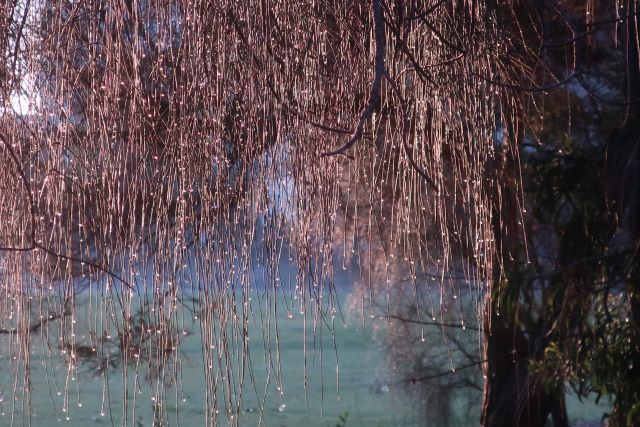
Gio observes that caterpillars are the favourite food of many bird species, particularly when rearing young, so the diversity of caterpillars on a tree can be useful measure of that tree’s importance in the food web. Furthermore, many caterpillars have specialised associations with certain plants with which they share an evolutionary history. To illustrate his point, he observes a locally rare Pallid Cuckoo with a She-oak Moth caterpillar in a Drooping She-oak on the foreshore.
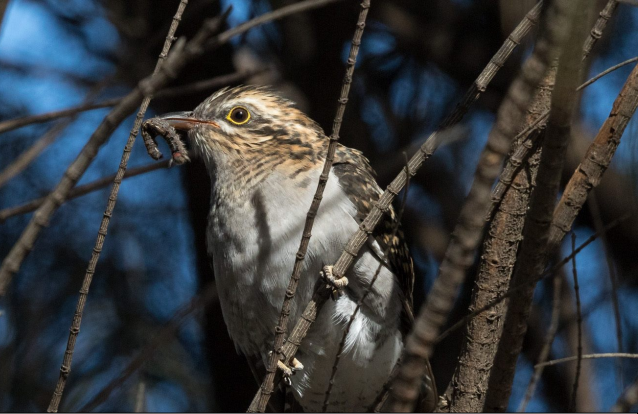
‘A food web based on an indigenous plant, feeding a specialised insect which is feeding a specialised bird. All have evolved together and, in effect, know each other. The She-oak Moth caterpillar’s physiology is specially adapted to the tannins and specific chemical defenses of the tree and the cuckoo is able to eat caterpillars (despite its irritating hairs) because it routinely sheds the lining of its stomach. As amazing as they seem, these specialised relationships are not exceptional but the norm in nature.
They depend on indigenous plants being present to begin with’.
There are 504 casauarinas in Port Melbourne, more than plane trees. The trees may not be showy, except when the males are in full flight of flowering. They provide homes and food for smaller birds away from aggressive big birds, especially noisy miners. For their important role in local biodiversity, let’s hope we see more of them planted.
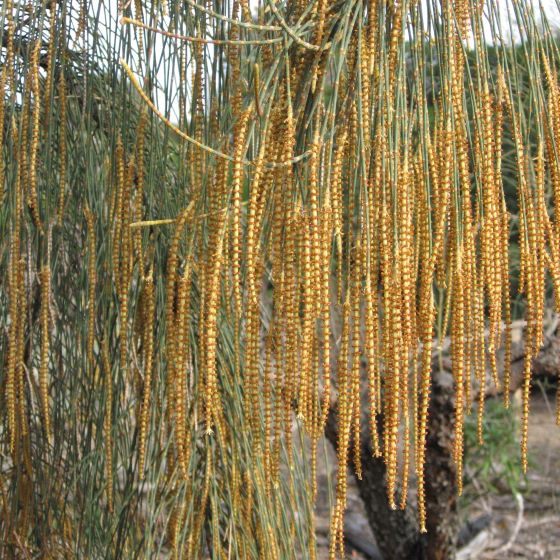
More
With many thanks to Gio Fitzpatrick for permission to quote from Seeing the urban forest for the trees, Considerations and recommendations for the Bayside Urban Forest Strategy 2021
1 Greening Port Phillip Street Tree Planting Program 2017 to 2022, City of Port Phillip 8 January 2019
2John Evelyn Sylva or a Discourse of Forest Trees and the Propagation of Timber in His Majesty’s Dominions Volume One published as The Project Gutenberg eBook in 2007, first published in 1664
3 Sydney Morning Herald 5 January 2005
4 Mistletoe Biodiversity research and monitoring, City of Melbourne
6 Comments
-
-
John Milne
Yes, very interesting to read of the Plane Trees, their'Kissing canopy', and the Drooping She-oaks with Gio's comments, Janet.
-
Brendan Baxter
Excellent discussion, thank you very much Janet. I see similarities with the emerging conversations around balancing our history of 'showy' palm tree planting with the increasing need to plant species that better enhance and protect public spaces from the effects of climate change, such as those that offer more shade and habitat.


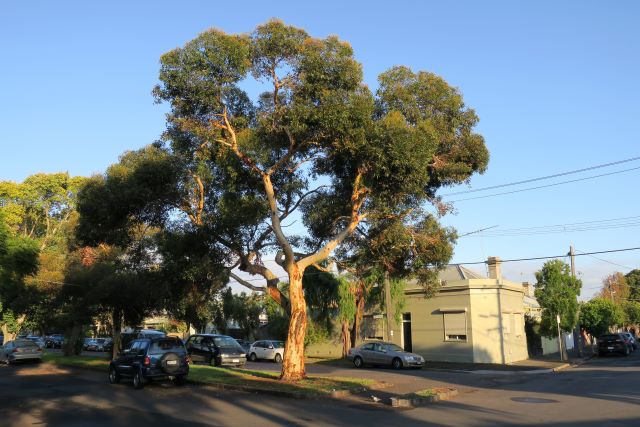
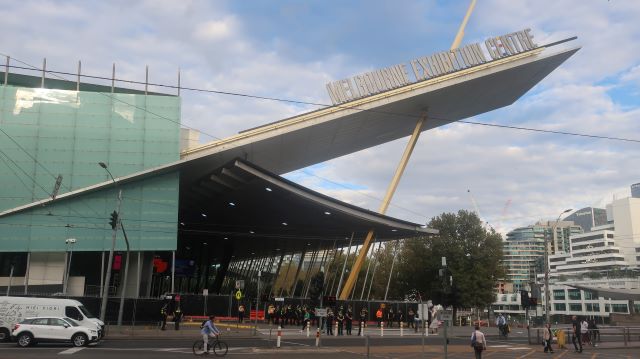
Linda Norman
Very interesting history of tree planting in Port Melbourne. It is indeed interesting to see arguments for a particular tree planting strategy change over time. We are also finally coming to the realisation that global warming will also significantly impact urban, as well as rural environments. Thank you Janet.